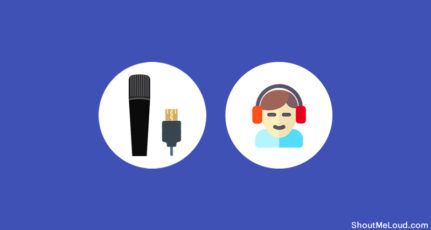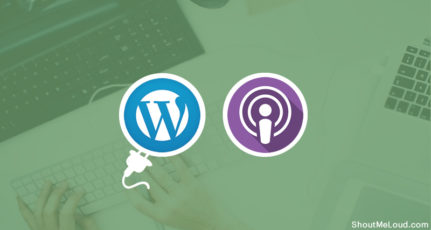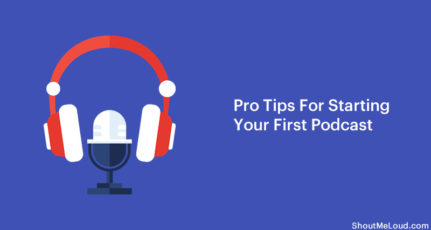
Podcasting is one of the fastest-growing industries worldwide due to its high impact. Statistically speaking, podcasting is growing by leaps and bounds as it is the most intimate way to consume content.
From a financial perspective, 51% of monthly active podcast listeners in the U.S. have an annual household income of at least $75,000 compared to 38% of the general population.

As this is a growing content platform, it means it’s a great opportunity for you to reach out to your target audience in one of the most effective ways.
This Podcasting 101 guide will help you to launch your podcast in no time. If you have been sitting on the sidelines and thinking, should I launch my podcast and how should I do it, this guide is the answer to all your questions.
I have provided everything that you need for starting a podcast. So, grab a cup of coffee, bookmark this guide, and get started.
The Steps of starting a podcast:
For the first-timer, these are the steps involved to launch your podcast. I have provided all the resources below which will help you to get everything in no time. It’s better if you take one week to get all below mentioned basic stuff in place and then launch your podcast.
Here are the steps of starting a podcast
- Work on podcast name and niche
- Get your podcast cover image
- Get Podcast intro + outro music
- Get Podcasting equipment
- Create an environment and process
- Record your first podcast
- Get Podcast hosting
- Upload & publish your first podcast
- Publish your podcast on iTunes, Google podcast, and more
- Promote Your Podcast
The #1 lesson before starting a podcast
Before you get started, let’s reinforce the idea and reason for which you are starting a podcast.
As the podcast is an exploding content platform and unlike blogging or video-blogging, it is less technical and solely relies on the knowledge that you want to share with the world. Since not a lot of people are doing it around you, it’s a great opportunity for you to be the first one to get started.
The podcast listener is on the rise and you can see from the below chart (even though it’s a bit old), the numbers are growing exponentially.

If you are someone who loves numbers to make a decision, the above chart clearly indicates the exponential growth of podcasting listeners. Since it’s also backed up by high-income consumers, you have a great opportunity right away to encash on.
Being an on-demand consumption media, consumers are more likely to act on your recommendation. Be it promoting your own product, service, or any other option, podcast marketing is becoming effective for many brands.
If there is one message, that you should keep in mind while creating your podcast content, it should be:
Inform, Educate & Entertain
While you are sharing your hard-earned knowledge, be a good educator and entertainer. Keep your audience’s interest in mind while recording, and you will be creating only high-quality content. Another thing that has always worked out for most podcasters is to entertain. Make the learning fun and your podcast show will be the talk of the crowd.
And now, it’s time to get started...
Basics: What do you need to start a podcast:
Alright, let’s get the basics right. Here are a few things you should have before you record your podcast:
Podcast name: What should be your Podcast name?

There is three simple podcasting naming convention you could follow:
- Personal name: Ex: The Harsh Agrawal Show, #AskHarsh Show
- Creative name: ShoutMeLoud
- Descriptive name: The Fashionista Show| The Content Marketing Show
A good way to plan your podcast name is like this:
Podcast name | Tag line
Ex: ShoutMeLoud Podcast – Where digital markers hangout
- A personal name is great when you are planning to host your show yourself and build a personal brand.
- Creative name: If you are a creative sort of person, let it reflect in the name you choose.
- Descriptive name: When you target a niche or category, this could give you a great edge.
For fresh podcast name inspiration, head over to the top podcast charts. Once you have finalized your podcast name, here is one thing you could do to test.
Reach out to your friends and business colleagues and ask
Hey, I’m doing a podcast with “______”, what do you think this podcast is about?
To make this survey effective, you should reach out to a minimum of 5 people.
Podcast subtitle (Benefit ex: grow your online business)
Like the Podcast name, your subtitle will help users to understand who is the podcast for and why they should listen to it. Planning it initially will also help you to narrow down your niche and you would be able to pick 1-2 solid ideas from a lot of ideas in your head.
Create cover art for the podcast (Design)
The design plays an important role in the growth of your podcast. Establishing a design guide will help you in the long run to maintain a consistent brand.
When you are launching your podcast, you will be needing graphics for the following:
- Channel Cover art
- Episode cover art
Whenever you are uploading a new podcast show, your podcast host will require you to upload a channel art.
Here is what you should do:
- Pick a color template for your channel: Based on the audience you are targeting, you should pick the right color. Read this guide on color psychology to understand what color would be best for your target audience.
Here are cover art specs from iTunes:
- Artwork: minimum size of 1400 x 1400 pixels and a maximum size of 3000 x 3000 pixels, 72 dpi, in JPEG or PNG format with appropriate file extensions (.jpg, .png), and in the RGB colorspace
- All podcast episodes, XML, and artwork are hosted on publicly addressable servers with byte-range requests enabled. (This is usually taken care by your hosting)
Here is a great tutorial by Ana on creating Podcast cover art.
Create Intro/outro music :
Having an intro and outro music adds an element to your podcast. This will be an integral part of your podcast show. In the past, I have used a service like Fiverr to get a podcast intro/outro done for my show. It cost me about $15 and as a one-time investment, it was worth it.
Podcast equipment and software:
At this stage, it’s important for you to pick some of the best equipment and software for your podcast. Some of the things you need:
- A quiet space
- A good mic
- Software to record solo and edit
- Software to record guest interviews
- Podcast hosting
Podcasting mic:

When it comes to mic, Blue Yeti is the most popular choice among podcasters. The directionality feature of Yeti ensures that you can set it up for various situations, such as When you are recording solo, when you are recording with a guest, or even when you are recording in a group.
In case, if you are looking for more recommendations, you should check our earlier guide on the best podcast microphone.
Podcast recording software:
There are many software and tools that you can plug in your mic to start recording your podcast. Here are some of the best and most used software:
Auphonic: This mobile app is an audio recorder and editor. It also helps you measure the noise in the room which is perfect for you to make changes in your recording setup if required. Once the recording is done, you can straight away send it to the Auphonic server for post-processing.
The app is available for Android and for iOS as well.
Camtasia:
Camtasia is a popular screencasting tool that could be used for audio recording as well. In fact, you would be surprised how easy it is to record audio using Camtasia. The software is a paid one and is available for Windows and Mac. The software offers features such as noise cancellation, easy editing, and voice leveling to name a few.
Garageband:
Garageband is free iOS software that could be used on Mac, iPhone, and iPad as a DAW (digital audio workstation). The software is easy to use and you can easily edit your audio files to add intro/outro, add sound effects and do a bunch of other things to create an outstanding podcast show.
Podcast hosting:
Once you have recorded your podcast, the next thing is to host them on a podcast hosting service. These podcast hosting services will provide you with an optimized RSS URL, which will help you to publish your podcast on iTunes, Google Podcasts, Sticher, and other podcast services.
There are many free and paid podcast hosting services out there. Here are some of my favorites:

Buzzsprout: Idle for newbies and experienced podcasters. They have a free and paid plan which fits perfectly for anyone who is trying out or podcasting for money. They also offer WordPress plugin and many beginner’s guides that would help you start your podcast as well as grow it.
Other options are:
Before you record your first podcast:
By now, you are all set with essential equipment and tools for recording and launching your podcast. The next thing is to prepare a few things before you start recording your first podcast.
Topic ideas: You should have at least 6-10 podcast topic ideas ready. At the time of launch, you should be ready with at least 3 podcast shows for continuous publishing. You can use good-old Google sheets or Trello to manage your topic ideas.
Welcome message: The welcome message is going to be a pitch about who you are and why you matter.
Script and outline for every topic:
For every topic, you should have the following ready:
- The topic
- A brief outline of the episode
- The main takeaway of the episode
I usually keep this ready in a Google doc. The planning at this stage will ensure you can get in the flow state when you start recording the show.
Record and Edit your first podcast
Now, it’s time for you to record your first podcast show. I would normally record 3-4 podcasts in one sitting. A lot of users like to record only one podcast a day, which is fine as long as you are following your podcast publishing schedule.
The editing of the first few podcasts show is usually time-consuming but after that, it becomes easier. If you can edit it yourself, then nothing like it. But if you are someone like me who believes that time is money, you can hire a freelancer from Fiverr or hire a virtual assistant to edit the podcast for you.
This is the format I use for Podcast editing:
Teaser + Intro + meat + ad + meat + CTA + Meat + Subscription/review reminder + Outro
What’s next after the final production?
Glad you asked, as this part is quite essential for your podcast to be able to reach the right ears.
The first few things you should be doing are: (This is a one-time thing)
Upload your podcast to your podcast host with show notes and any other details.
- Submit your podcast to iTunes
- Submit your podcast to Google Podcasts
- Submit your podcast to Sticher
- Submit your podcast to Soundcloud
The process is also easy, as you only need to submit the RSS feed generated by your podcast hosting to these podcast submission sites.
This submission to the above platforms (iTunes, Google Podcasts, Sticher) is required only one time. In the future, you only need to upload your podcast to your podcast host and your new episodes will be automatically added to these podcasting sites.
Marketing your podcasting:

What’s the worse thing about throwing a party?
Not sending an invite.
The same is true for any podcast. After releasing your podcast, now it’s time for you to let the world know that your podcast is live.
If you already have an existing channel like YouTube, Blog, email-list, or social media, use it to announce your podcast.
You should also submit your Podcast to the directories.
Here is a comprehensive podcast directory list by Ross Winn (A great guy).
Here is the list of Social-media sites where you can share your podcast:
- YouTube
It is also a good idea to spend some money on advertising your podcast to the right audience.
It is natural to not get many views on your first few podcasts but as you continue publishing, the listener will be browsing your old shows as well.
You should also bookmark Headliner which helps you create a video version of your podcast, that could be used on YouTube, Instagram, or other social networking websites.
Well, these are the definite steps you can follow to start a podcast today. Just to make your life easier, here are a few additional tips for podcasting that you should remember:
- Set a definite date and time for publishing
- Have one evergreen recorded podcast (As a backup plan)
- Mention the Website link at the start & end of Show notes
- Use an animated video overlay and publish your podcast on YouTube.
- Connect with the best minds in your industry by inviting them to be a guest on your podcast show.
Here is a FAQ related to Podcast
You can use Anchor.fm to start your podcast for free. It’s a great free platform for launching your podcast. This is perfect for anyone who would like to start a podcast for free.
BuzzSprout – For hosting your podcast
Blue Yeti – For recording audio in high quality
Headliner – For Podcast promotion
Yes, you can create a podcast from your phone using an app called Anchor.fm. All you need is a decent recording mic for the phone like Rode Smartlav+ and a quiet place.
Conclusion: How to start a podcast
Well, now is the best time to start a podcast. The above steps are all you need to launch your podcast.
In case you wish to add any new tips, feel free to let me know in the comment section below.
Here are a few hand-picked guides for you to read next:
- 5 Best USB Microphones for Podcasting
- Best WordPress Podcast plugins
- Ringr review: Record Podcast with a remote host






@Harsh Agrawal – Thanks for this article. I am going to start my podcast soon. What do you think about RINGR? Have you ever used it?
@Jay
I have used Ringr, and I feel its a good solution for recording with a guest. You can read my review and experience here: https://www.shoutmeloud.com/ringr-review.html
I assume you have a subject that you want to do a podcast about. If you do not, ask yourself what you are passionate about and can you talk about that each week. Then you may begin.
So you have a subject for your podcast. Now you need to do some things.
Think of a name for your show.
Create a logo
Bring on a co-host or co-hosts (1 is good, two is better)
Decide if it is going to be a daily, weekly or bi-weekly show.
Sign up with WordPress, Libsyn, Buzzsprout or any other podcast hosting sites.
Create your podcast site page.
Download Audacity and install it on your computer.
Purchase a Good quality USB microphone for you and your co-hosts
If your co-hosts are remote, they will have to get their own mics, but ensure they have the same as you.
Establish a Skype or Google Hang-outs account (you’ll need this eventually anyway)
Hi Harsh
Thank you very much for this great share.
Reji Stephenson
Podcast is rising significantly in the digital world.
Theres not much load when it comes to doing podcast. All thats needed is your knowledge in what you plan talking about.
Henry